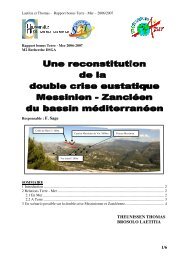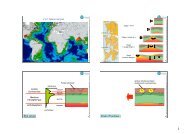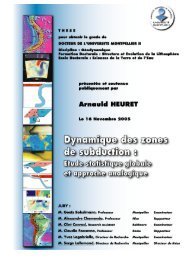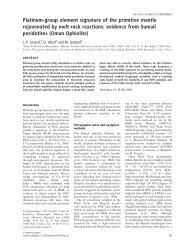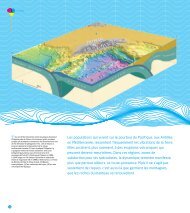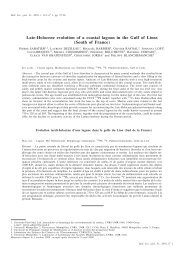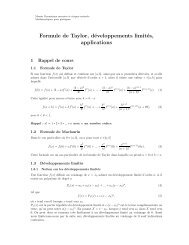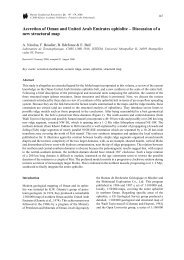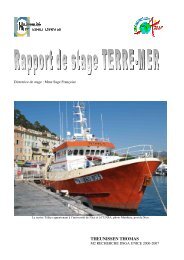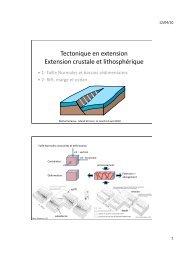Géochronologie U-Pb par ablation laser et ICP-MS (LA-ICP-MS ...
Géochronologie U-Pb par ablation laser et ICP-MS (LA-ICP-MS ...
Géochronologie U-Pb par ablation laser et ICP-MS (LA-ICP-MS ...
You also want an ePaper? Increase the reach of your titles
YUMPU automatically turns print PDFs into web optimized ePapers that Google loves.
Chemical Geology 184 (2002) 151–165<br />
www.elsevier.com/locate/chemgeo<br />
Monazite ‘‘in situ’’ 207 <strong>Pb</strong>/ 206 <strong>Pb</strong> geochronology using a small<br />
geom<strong>et</strong>ry high-resolution ion probe. Application to<br />
Archaean and Proterozoic rocks<br />
Delphine Bosch a, *, Dalila Hammor b , Olivier Bruguier c , Renaud Caby a ,<br />
Jean-Marc Luck d<br />
a Laboratoire de Tectonophysique, Université Montpellier II, CNRS-UMR 5568, cc 066, Place Eugène Bataillon,<br />
34095 Montpellier Cedex 05, France<br />
b Dé<strong>par</strong>tement de Géologie, Université d’Annaba, B.P. 12, El Hadjar Annaba, Algeria<br />
c Service <strong>ICP</strong>-<strong>MS</strong>, ISTEEM, Université Montpellier II, cc 049, Place Eugène Bataillon, 34 095 Montpellier Cedex 5, France<br />
d Laboratoire de Géophysique, Tectonique <strong>et</strong> Sédimentologie, Université Montpellier II, CNRS-UMR 5573,<br />
cc 060, Place Eugène Bataillon, 34 095 Montpellier Cedex 5, France<br />
Received 19 March 2001; accepted 2 August 2001<br />
Abstract<br />
This paper reports the application of secondary ion mass spectrom<strong>et</strong>ry (SI<strong>MS</strong>) using a small geom<strong>et</strong>ry Cameca I<strong>MS</strong>4f ion<br />
probe to provide reliable in situ 207 <strong>Pb</strong>/ 206 <strong>Pb</strong> ages on monazite populations of Archaean and Proterozoic age. The reliability of<br />
the SI<strong>MS</strong> technique has been assessed on two samples previously dated by the conventional ID-TI<strong>MS</strong> m<strong>et</strong>hod at 2661 F 1<br />
Ma for monazites extracted from a pelitic schist from the Jimperding M<strong>et</strong>amorphic Belt (Yilgarn Craton, Western Australia)<br />
and 1083 F 3 Ma for monazites from a high-grade <strong>par</strong>agneiss from the Northampton M<strong>et</strong>amorphic Complex (Pinjarra<br />
Orogen, Western Australia). SI<strong>MS</strong> results provide 207 <strong>Pb</strong>/ 206 <strong>Pb</strong> weighted mean ages of 2659 F 3Ma(n = 28) and 1086 F 6Ma<br />
(n = 21) in close agreement with ID-TI<strong>MS</strong> reference values for the main monazite growth event. Monazites from the<br />
Northampton Complex document a complex history. The spatial resolution of about 30 mm and the precision achieved<br />
successfully identify within-grain h<strong>et</strong>erogeneities and indicate that monazite growth and recrystallisation occurred during<br />
several events. This includes d<strong>et</strong>ection of one inherited grain dated at ca. 1360 Ma, which is identical to the age of the<br />
youngest group of d<strong>et</strong>rital zircons in the <strong>par</strong>agneiss. Younger ages at ca. 1120 Ma are tentatively interpr<strong>et</strong>ed as dating a<br />
growth event during the prograde stages of m<strong>et</strong>amorphism. These results demonstrate that the closure temperature for lead<br />
diffusion in monazite can be as high as 800 °C. At last, ages down to ca. 990 Ma are coeval with late pegmatitic activity and<br />
may reflect either lead losses or <strong>par</strong>tial recrystallisation during the waning stages of m<strong>et</strong>amorphism. A third unknown sample<br />
was analysed to test the capability of the in situ m<strong>et</strong>hod to date younger monazite populations. The sample, a pelitic<br />
m<strong>et</strong>atexite from Northwestern Hoggar (Algeria), contains rounded m<strong>et</strong>amorphic monazites that provide a 207 <strong>Pb</strong>/ 206 <strong>Pb</strong><br />
weighted mean age of 603 F 11 Ma (n = 20). This age is interpr<strong>et</strong>ed as recording emplacement of a gabbronoritic body during<br />
amphibolite facies regional m<strong>et</strong>amorphism and is representative of the late pulse of the Pan-African tectonom<strong>et</strong>amorphic<br />
* Corresponding author.<br />
E-mail addresses: bosch@dstu.univ-montp2.fr (D. Bosch), bruguier@dstu.univ-montp2.fr (O. Bruguier), caby@dstu.univ-montp2.fr<br />
(R. Caby), jmluck@dstu.univ-montp2.fr (J.-M. Luck).<br />
0009-2541/02/$ - see front matter D 2002 Elsevier Science B.V. All rights reserved.<br />
PII: S 0009-2541(01)00361-8



